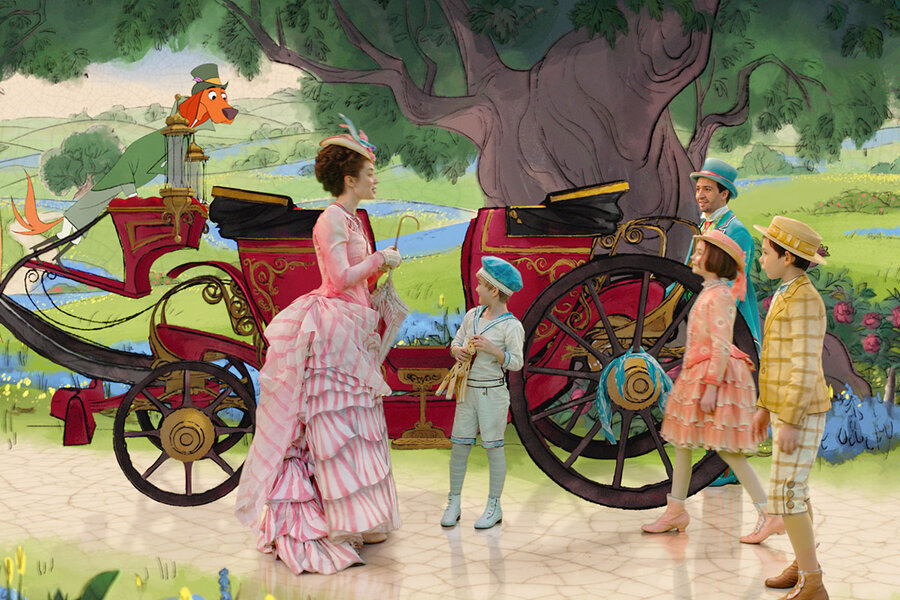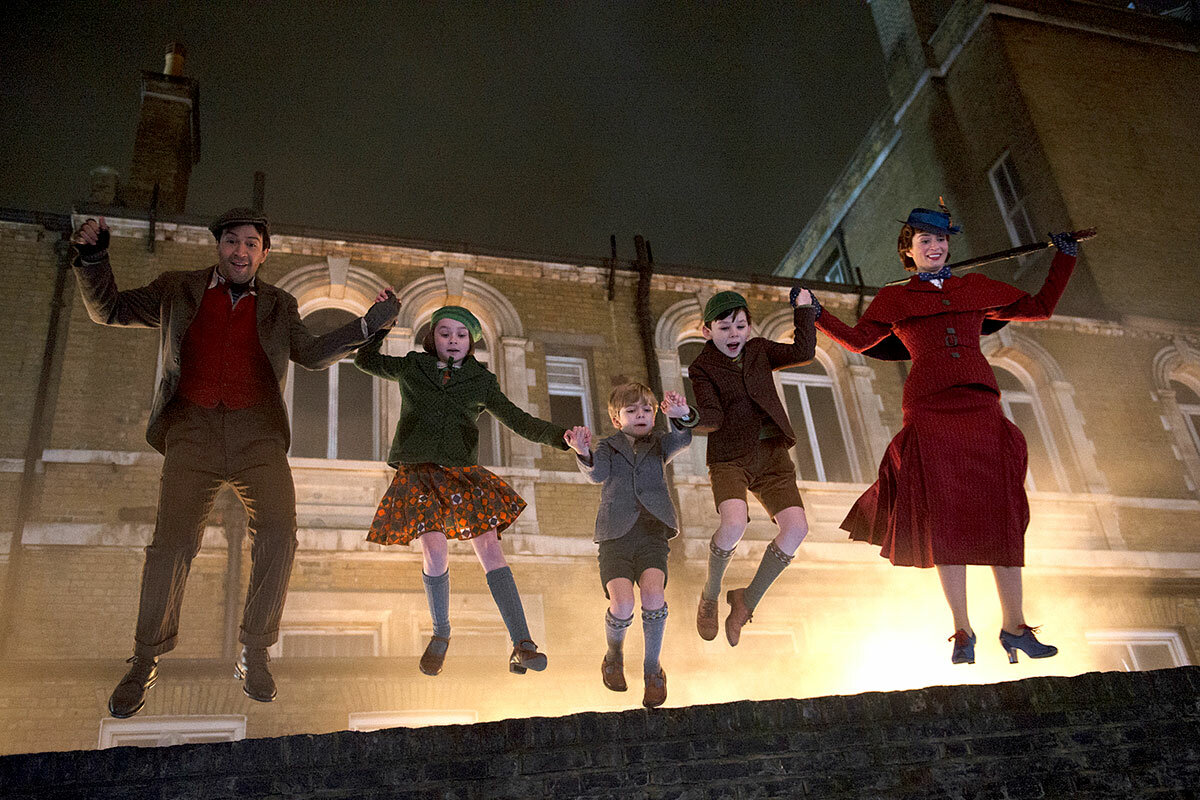‘Mary Poppins’ makeover: A new story, a new vision of Cherry Tree Lane
Loading...
Behind the marquee actors in “Mary Poppins Returns” – Emily Blunt, Lin-Manuel Miranda, and Meryl Streep – is a team of people whose job it is to solve problems like how to get a grand piano to hang upside down from a ceiling. Oscar-winning production designer John Myhre is chief among that group, overseeing everything from furniture to shrubbery. “As a designer, you’re not just designing pretty sets, you’re designing sets to help tell the story,” he explains. For Mr. Myhre and his collaborators, the challenge with the sequel, opening Wednesday, was to create visuals that connect to the original film but that allow for a new adventure set some 20 years later. “I really embraced 1934 in England,” he says, noting that the first of the books by P.L. Travers about the magical British nanny was published in 1934. “It … really suited our story, which is a completely different story from the first movie.”
Why We Wrote This
John Myhre was a fan of the 1964 classic film as a child, and now he’s helping bring its sequel to a new generation. How a production designer tackles envisioning the new with a nod to the old.
“Mary Poppins” was the first movie John Myhre saw in a theater. At Seattle’s Northgate Theatre in the 1960s his imagination was ignited by a Disney character come to life.
As the 6-year-old walked in, there was a full-size figure of Mary Poppins, complete with umbrella and carpetbag.
“This was the greatest thing in the entire world,” Mr. Myhre remembers of his reaction. “So maybe that’s what made me a designer. I was looking at that figure of Mary Poppins [and thinking], ‘Anything is possible.’ ”
Why We Wrote This
John Myhre was a fan of the 1964 classic film as a child, and now he’s helping bring its sequel to a new generation. How a production designer tackles envisioning the new with a nod to the old.
Five decades later, the Oscar-winning production designer got his childhood dream job: the chance to design a world for the magical nanny. As the production designer on “Mary Poppins Returns,” which debuts Dec. 19, Myhre has had a hand in everything from the furniture in the children’s nursery to the use of real greenery on iconic Cherry Tree Lane.
For Myhre and those he collaborates with – including the animators, costumers, and director – the challenge with the sequel was to create visuals that connect to the Oscar-winning original, but that allow for a new adventure set some 20 years later.
“I really embraced 1934 in England,” he says in a phone interview, noting that the first of the books by P.L. Travers about the British nanny was published in 1934. “It was a really terrific, rich period that really suited our story, which is a completely different story from the first movie.”
The original, starring Julie Andrews and Dick Van Dyke, is still beloved today. It won Oscars for editing, visual effects, score, song (“Chim Chim Cher-ee”), and its star.
Ahead of the official opening, the sequel has scored 78 percent on Rotten Tomatoes, with some mixed reviews. But it also has four Golden Globe nominations, including best picture in its category of musical or comedy.
Myhre, a two-time Oscar winner for art direction (“Chicago,” “Memoirs of a Geisha”), has seen the original “Mary Poppins” many times since that first theater visit as a kid, but says he referred to it less for the new film’s source material. Myhre notes that he and his collaborators based their vision on the new script, written by director Rob Marshall. “As a designer, you’re not just designing pretty sets, you’re designing sets to help tell the story.”
When we first reunite with the Banks family in “Mary Poppins Returns,” Michael (Ben Whishaw) from the original is grown and has children of his own. He’s going through tough times after the death of his wife and subsequent financial struggles, troubles echoed throughout the country as 1934 England experiences “the Great Slump.”
Knowing what the Banks’s world really would have looked like is an important consideration of Myhre’s. He says he immerses himself when creating a look for a movie. “I always research what is absolutely correct and I share that with the director and the writers and the producers,” he says.
That knowledge lets them then wander off in other directions. “If we decide we want to bring in something that’s from a slightly different period,” he explains, “we know what was real and we can make those choices.”
They did just that in an animated sequence in which Mary (Emily Blunt), lamplighter Jack (Lin-Manuel Miranda), and the three Banks children (Pixie Davies, Nathanael Saleh, and Joel Dawson) visit what appears to be a “turn-of-the-century vaudeville hall,” explains Myhre.
One of the most challenging sets for the design team was reportedly that of the home of Mary’s cousin Topsy (Meryl Streep), as everything – including the grand piano – had to be hung upside down.
“It’s two big hats, right?” says David Christopher Krause, an assistant professor in the cinema and television arts department at Columbia College Chicago, where he also coordinates the production design curriculum. “The sort of imaginative and fun part of trying to dream up a world that meets a director’s vision and then at the same time figuring out how to make all that actually happen.”
But “Mary Poppins Returns” begins and ends on Cherry Tree Lane. When the movie opens, the scene is “very gray and gritty,” Myhre explains. “It was an uneasy world we come into, with the Slump.”
It is only when happy times come again, that the street “bursts into beautiful pink cherry blossoms,” he says, adding jokingly, “I’m not giving anything away by saying it has a happy ending.”
His team used more than 900,000 silk cherry blossoms on the trees, he estimates, but they also used real greenery to express the newfound happiness of the Banks family. “We brought in grow lights just to kind of make the shrubs get a little more greener and happier,” he says.
“But in a real Mary Poppins, magical moment, a week after we put on grow lights, most of the bushes and shrubs started blooming.”
“I feel like I’ve got the best job on the movie,” Myhre says.









